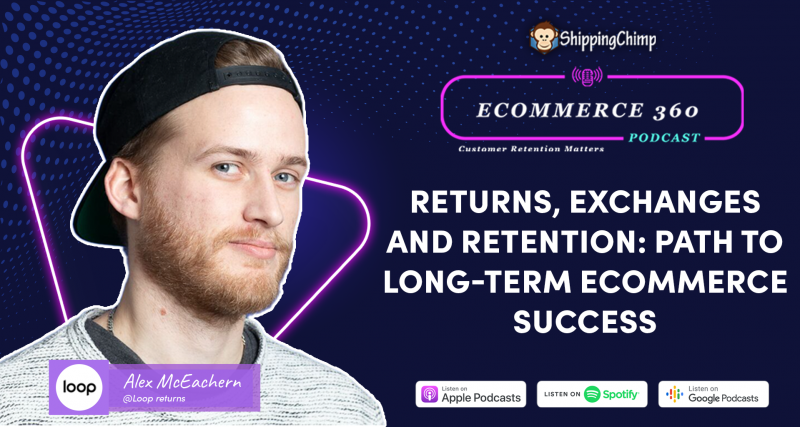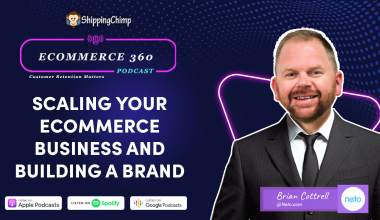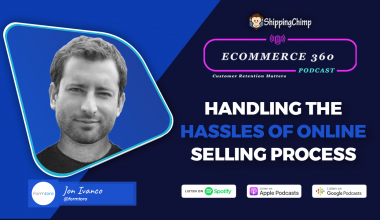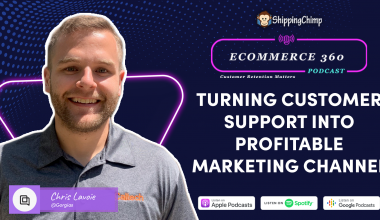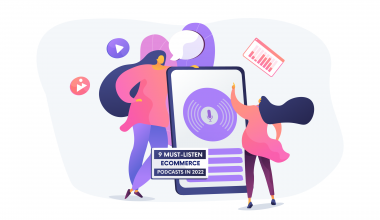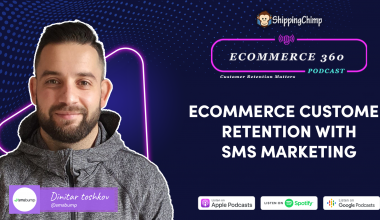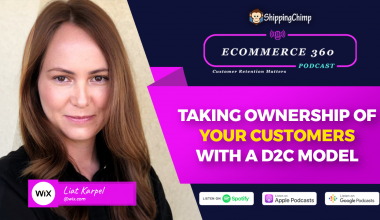In conversation with Chris from Loop returns, we talk about:
- How can eCommerce businesses handle their biggest nightmare: Returns?
- What are distinct trends in return activity that you have discerned?
- Do easy returns make a strong case for more purchases?
- ECommerce returns and metrics that matter
- How to personalize returns?
- Between acquisition and retention, what are brands choosing?
- Why must eCommerce pay attention to retention strategy?
- What’s the #1 way to improve eCommerce customer retention?
- What are the biggest hurdles to adopting a customer retention strategy?
- When do eCommerce brands start reaping the benefits of an effective retention process?
Watch the video here:
Revathi Karthik: Hey, guys, welcome to eCommerce 360. We have Alex today. Alex is the marketing manager of Loop Returns, to say the least, Loop Returns is an e-commerce company that automates returns and exchanges on Shopify.
Alex, Do you want to talk a bit about yourself, about your podcast, about your own company that you are running?
Alex McEachern: Sure. I always say that the hardest question in any interview is the tell me more about yourself. I always feel like that’s the hardest one for me to answer, but yeah, like you said, marketing manager at Loop Returns. I also have my own retention consulting agency called Spark Retention, so helping e-comm brands retain more customers and boost their repeat customer rate. I’m also the co-host of a podcast called The Exchange and we talk all about customer retention, brand building, and customer experience, so podcast is all about the tactics that you can use on the other side of acquisition. So, we don’t talk about advertising at all. We talk about everything else you can do in e-commerce.
Revathi: Okay, that’s great. Also, can we get started on a bit about Loop Returns, and then move onto Spark? So, the reason why we want to talk about Loop Returns is returns account for 20% to 30% of e-commerce sales and it’s the biggest nightmare for any e-commerce business, so how does Loop Return alleviate this pain point a bit for e-commerce companies?
Alex: Yeah, so at Loop, we like to say, like, a lot of people do view it as a nightmare right now but we actually like to view it as more of an opportunity than a nightmare, so like you said, somewhere between 20% and 30% of purchases are going to be returned, and that’s going to vary based on industry, so 20% is probably like an apparel brand, once you get up into that 30%, it’s going to be footwear. Now, what we say at Loop is that you don’t want customers to, a lot of people are going to say, “Hey, if a customer keeps something, that’s great,” like I don’t want them to be returning this but that’s because we often used return and refund synonymously.
A lot of brands are saying, “If something is going to be returned, I’m giving the money back to the credit card and I’m losing out on that sale,” but on Shopify, 52% of returns that happen are actually because someone has the wrong size, so more often than not, when someone comes to return something, they’re actually looking for an exchange, not a refund. So, if you look at returns as it could be a refund, it could be store credit, it could be an exchange, then you could start to say,
“Okay, when these come back as a return if I can offer up an exchange,”
and that’s what Loop specializes in, is I can keep that customer, I can convince them to come back and make another purchase, or if they’re finding something that they really love, that word-of-mouth, that referral rate is going to go up as well.
Revathi: That’s great. So, what you’re saying is Loop Returns is focusing on making returns seamless because they want to have an increased personalization to help customers simplify the return process for engaging them more with the product rather than just getting a refund, right? That’s great. So, you probably have analyzed a lot of data with respect to returns, right?
So, what are some of the interesting findings that you have learned so far like is there a trend or a pattern like we were talking about before about the pandemic, the returns have gone up or gone down, is there any particular pattern that you discerned while analyzing new data?
Alex: Yeah, so it’s interesting, we haven’t so far seen a huge change on return activity to the pandemic, so obviously, volume’s up, and volume’s up everywhere in e-commerce. Sales are up – pretty much everything in e-commerce is up right now, but returns as a percentage, like we were talking about before, hasn’t really changed much due to the pandemic.
Some of the more interesting things that we’ve been seeing lately is talk about, like, your return window, so a lot of people, if we go look at 10 sites right now, I bet nine of them have a 30-day return window, it’s kind of just become the standard.
One thing that we’ve noticed is that around 80% of the returns happen in the first 14 days, so the vast majority of people returning something are going to do it pretty quickly, and that makes sense, right? Like, I got something, it doesn’t fit, I want to get into the right product. So, it’s interesting because when you look at everyone with a 30-day return window, the majority of it is happening in 14 days, so people might say,
“Hey, I want to switch my return window to 14 days since 80% is happening then,”
I’d actually argue that it shows us that we can start to be making more generous return windows. If the vast majority of the volume is going to happen right at the beginning anyway, you’re not actually losing out on much by extending that out and going from, like, a 30-day window to a 90-day window that you can then turn your return policy into a bit of a marketing asset for yourself.
Revathi: That’s very fascinating, so what you’re saying is why have a 30-day window when you can get most of the returns, 90% of the returns are going to happen in 14 days? So, that’s a very interesting insight. So, in continuation to that, is there a correlation between returns and repeat purchase rates?
Do easy returns make a good strong case for more purchases? Is that what you see in the trend?
Alex: Yeah. So, we’re actually in the process of doing a big analysis of this at Loop right now and I’ll make sure that we can follow up with it as soon as we’re done, but what we are seeing is that people who interact with a great returns policy, we are seeing a lift in LTV.
The exact amount, we are still trying to figure out what that is but we are starting to see a relationship between a great returns experience and lifetime value, and is that increase in lifetime value coming from higher purchases after, once they know that a return is easy? Are they more likely to buy more in the future or is it causing more repeat purchases? We have to dig into that a bit further, but the LTV is increasing.
Revathi: I think that pretty much, the question that I was going to ask you later, like, what metrics are going to have an impact because of the efficient return process? I think mostly, what you’re saying is LTV is going to see an immediate impact. Are there any other metrics that you foresee having any impact due to efficient return process or if brands can optimize their returns ? Why do they have to measure it? How do they go about measuring which metric they have to go about measuring for being an impact?
Alex: Yeah, so I think a lot of brands, when they think about returns, they’re go to metric for measuring, like, how effective they are is return rate, so what is the percentage of all of my orders that are coming back? We talked a bit about that in the beginning of the episode, I think a lot of people also try to evaluate their returns policy based on, like, cost savings. So, what am I paying per shipping label? How can I be more efficient there?
But what we’re actually seeing is the top brands are shifting away from treating returns as a logistics play and they’re starting to shift it into a customer experience and a marketing play, so when they do that, they start to look at a couple of different things.
So, instead of looking at return rate, and if we say, “Hey, we want the return rate to be as low as possible,” we are always going to be trying to do things that drive that down, and what’s the easiest way to drive your return rate down? Hide it, bury it, put it in the footer, bury it in your FAQs, like, don’t let anyone find it, but if we are saying that seamless and easy returns, and more importantly, exchanges experience is going to lead to higher lifetime value, then you need to look at returns differently.
Instead of looking at it as a return rate, we call it like the return composition, so start to evaluate what percentage of all of your returns or exchanges? Because a return doesn’t have to be bad. If we can get someone into a new product that they love, that’s going to be good for us long-term, so what I would recommend is that everyone listening,
If you’re evaluating your return policy and your returns process, is take that return rate you’re probably looking at right now and break that down one step further, so you can see what percentage of all of your returns are coming in as refunds versus exchanges
Try doing things that are going to drive more exchanges and a higher exchange rate and a lower refund rate.
Revathi: That’s great. So, that’s exactly what I’m going to be talking about in my next question. It’s about personalization, right? So, when it comes to returns, brands do not consider personalization as something they can implement, whereas when you think about returns in terms of exchanges, you can still personalize the hell out of those exchanges as well. So, do you see brands extending personalization in their return process as well or what do you see?
Alex: Yeah, it’s interesting, like, personalization in kind of like the textbook definition, you gotta have a bit of that in the returns process, in the returns experience. I would say where you’re getting more personalization lately in e-comm is with that exchange experience, right? So, in the past, an exchange would be like, hey, you bought something, we’ll give you store credit, go and buy something else, where with a tool like Loop, you can actually, I don’t know, take a pair of jeans and say, hey, I want to exchange these and shop the catalog for something else.
So, not necessarily like the personalization level of, like, all these increasing recommendations but just making it a more personal experience, right? Like, if you think about our retail experiences, I don’t go in, go up to the counter, get store credit, go back out, shop, come back and, like, do all that. I do it all at once, and that’s the experience, that’s the level of personalization that people are looking for, especially with everybody coming online that was traditionally just retail shoppers.
Revathi: That’s great, that’s great. So, let’s talk about retention which is your favorite topic. You have been a forerunner for customer retention in the e-commerce space, and do you see businesses pivoting their strategies for stronger retention, or do you still see them clinging to acquisition?
Alex: More and more, we are seeing brands turn to retention that and we did in the past, so retention has been my main focus and something that I’m super passionate about for about five years now, and five years ago, people looked at you like you had two heads when you started talking about this. Acquisition was so cheap, so inexpensive, the market hadn’t really matured so acquisition was cheap and easy.
Fast forward to today and you’re seeing more brands pay attention to customer retention, but unfortunately, I still don’t think that the majority or even 50%, I would say, I’d say 75% of brands are still very acquisition-heavy and they might have, like, one person or they might be devoted, like $0.10 of every dollar they invest into marketing into the retention side versus the acquisition side, so it’s getting better but it’s definitely not solved or mainstream yet.
Revathi: Okay, it’s nowhere where we want it to be. So, just, I think before this interview, I went over your retention masterclass and you do make a very strong case for why brands should look at retention. Do you want to give us a brief look into why brands should give this retention strategy or their retention strategy the attention that they are not giving right now?
Alex: Yeah. I’ll try to be as brief as possible, but retention is really, in my opinion, the last place to compete with your marketing, so as I said in the answer to that last question, we are seeing acquisition costs rise, we are seeing the market get more competitive. I mean, I think Shopify, we’re crossing a million Shopify stores now and that’s just one e-commerce platform for all the brands that are vying for your customer’s attention, so customers have a ton of choice and they don’t need to come to buy from you just because they saw an ad, so the place where brands can invest in building that relationship with the customer, and I feel like a lot of people look at customer retention and go, “Oh, how do I get someone who made one purchase to make two purchases?” Yes, that is an important step but it’s all about establishing a relationship with that person. They aren’t always going to be able to buy from you depending on what you sell.
Someone’s not going to be buying every day, but the idea of customer retention is to build this sense of community, to build a sense of belonging. Some people will call it loyalty, some people will call it retention community, it doesn’t matter but being able to build up that base of people that are looking to you for everything to be a subject matter expert, to be the person that they turn to when they have a problem or an opportunity, like, that’s what leads to long-term success. The acquisition is like, if I turn the faucet off, my business dies. If you have a strong mix of acquisition and retention, even if I turn off that faucet of acquisition, my business is going to sustain and actually continue to grow with my existing customer base.
Revathi: So, building a real relationship with customers, so that’s a great retention strategy. Also, if you can talk to us about the effect of post-purchase communication, how does that actually fall into this retention strategy, how far can brands go with post-purchase communication to establish a great relationship with their customers?
Alex: Yeah, so retention marketing, like there’s a lot of facets of retention marketing, and post-purchase communication is what I call the low hanging fruit of retention, so anyone listening, if you’re getting into customer retention for the first time, that post-purchase communication is obviously, like, the biggest part of it.
It’s going to lead to the quickest results because retention, I like to say it’s like rolling a snowball, it’s exponential growth, right? It starts small and it gets bigger over time, but to get back to your question on how do you build that post-purchase communication, it’s number one, like, put yourself in the customer’s mindset, not yours, so I see way too many post-purchase flows where it’s like, hey, you made a purchase, and then within a day, it’s like, do you want to make another purchase? They haven’t even got that first purchase yet and you’re already encouraging them to make a second one, so think about the experience from their perspective, make sure that you’re offering the post-purchase communication at the right time.
So, in terms of the first couple communications, it might just be like, hey, like your package left our depot, your package is on its way, your package arrived, like, making sure that people understand when they’re going to actually receive this because in e-comm, it’s not like going to the store and I make a purchase and I hold it right away, there’s a lot of silence and there’s a big gap between when someone makes that first purchase and then they actually are able to hold and experience that thing, so you as a brand needs to make sure that you’re not just sitting there wondering and waiting.
When they do get the product though, you need to make sure that you’re telling them everything they need to know to be successful with it. So, some things are pretty easy, as a candle, I guess that candle, I light it, and I’m experiencing it. Let’s say you saw something like supplements or, I don’t know, shampoo, there is an element of education that goes into this to make sure that once they get it in their hand, they actually use it and they achieve what they wanted to get out of that. I bought the shampoo because I want stronger, thicker hair. Well, if I only use a little teeny tiny amount of it and I only do that every three days, I’m not going to get the results that I need from it. So, it’s that education piece and it’s making sure that you know when someone is likely to make a second purchase because again, we don’t want to just drop that onto the day after, but if you’re able to take a look at what your average time between purchases is or when do your best customers, your top 5% of customers, end up making a second purchase, you can start to line up your email, your SMS marketing with when that’s going to happen to increase the likelihood of that second sale.
Revathi: Right, right, right, relevancy and the timeliness of the post-purchase communication so that it doesn’t look too spammy, you don’t want to spam their inboxes, at the same time, you want to be there when they need you. So, we’ve spoken so much about retention and you have been advocating for customer retention strategies to almost all e-commerce brands that you consult.
What do you think is the biggest obstacle when it comes to adopting a strong retention strategy? What is stopping them from adopting a strategy which seems logically quite simple, right? It’s quite logical, but then they struggle to adopt it full-fledged. Why do you think that is?
Alex: Yeah, I think it’s not a timing thing but a how long it takes? So, a lot of people, as an example, like when I start talking to brands about retention and retention consulting, it’s harder because it’s that exponential growth, right? Like, you’re not going to see anything meaningful in the first couple of days, in the first couple of weeks. It takes a couple of months to build this up. If you’re going to build a community, if you’re going to build on retention, it doesn’t happen overnight, so I think that’s the hardest part for brands right now, is acquisition is, like, if I put $1,000 more dollars into my customer acquisition in Facebook or Instagram, like, I see the results pretty instantly, so when you’re a brand sitting there thinking about like, oh, I need to grow this year and where is that growth going to come from? It’s very easy for me in my mind to be like, okay, I put $1,000 here, and I get, I don’t know, $2,000 or, like, for a lot of people, they’d be like $1300 out, like, the return isn’t as good as it used to be, but that’s the biggest obstacle right now, is that
I get instant gratification from customer acquisition but it’s delayed gratification on customer retention, and that stops a lot of people from giving it enough time.
You see a lot of people jump in and start to work on it, and then they give up after like, two or three weeks. It requires constant effort and continual improvement and it requires enough time to see results.
Revathi: So, what is the typical timeline that you see brands start gaining from their efforts in customer retention strategy? Is there a specific timeline that we are looking at, maybe two years, three years, five years?
Alex: It really depends, like, if you’re looking on a year timeline, so five years out, you’re absolutely going to start seeing results if you’re doing it properly. I would argue that you can start to see results in a couple months. It really depends on what your time between purchases is, so earlier, we are talking about post-purchase flows.
I think that’s the lowest hanging fruit and the quickest turnaround of retention plate, but even that, if I sell, I don’t know, weighted blankets and if someone makes one of those purchases, like, twice a year or once every three years, no matter how good my post-purchase flow is, I still need to wait for the interval between those purchases to see results, so it’s going to vary based on what you sell, but with something like post-purchase, you can start to see results maybe, like, 2x your average time between purchases.
If you’re going for more like a content play or an organic social play, like, I would argue that takes at least six months to see anything meaningful start to come from that. It’s going to take time, you have to nurture it. It’s a lot like, I don’t know, planting a tree, like, it’s going to grow into something huge and awesome but you need to celebrate the steps along the way, like, when you see that sapling sprout from the ground, like, you just need to pay attention to that, or going to the gym,
If I go to the gym and I’m trying to lose weight or get more muscular and I don’t kind of take snapshots of my progress, I will never know how far I came, so I think that’s the biggest thing in retention, is what’s your repeat customer rate right now? What’s your AOV?
Like, taking all these benchmarks and just starting to measure that week over a week so you can start to see those small increases and that keeps you motivated to keep going.
Revathi: That is just a brilliant analogy, I think. That was a fantastic episode, Alex. Thank you so much for getting on this episode and talking to us about very, very interesting nuggets about returns, about retention, about how e-commerce brands should focus on their long gain, not their short-term gains, so it was fantastic. Thank you so much for being on the podcast with us today. Do you have any parting words?
Alex: I think give customer retention a try and make sure you give it enough time to actually see the results, and there’s a lot of, like I said, maybe 25% of people are focusing on retention right now, so if you’re one of the people listening to this episode and you’re saying, “Hey, this is something I want to get started with,” you’re putting yourself in front of the vast majority of e-comm right now and you’re giving yourself a great headstart, so the best time to start with customer retention is today, so find something and just get started.
Revathi: That was great, that was amazing. Thank you, Alex, thank you so much
- Top 5 Shipping Companies in Vancouver - July 26, 2024
- Best Strategies to Save on Shopify Shipping - July 11, 2024
- Top 10 Fulfilment Companies in Canada - July 10, 2024
